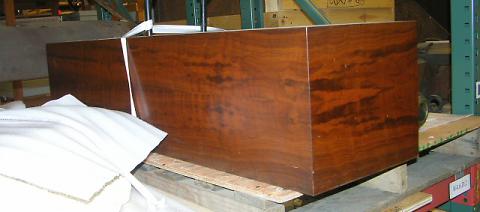H69.368.5
Cannon. Description: bronze presidio cannon.
History: Spanish
(B. Hopp, 1982) Cast in bronze. Single shot. Muzzle-loading. 2" bore diameter. 4.3 1/2" overall. 6 /12" cascable. 10" first reinforce with vent field astragal and reinforce ring and ogee. 22 1/4 chase with chase astragal. 4 1/2 muzzle with muzzle astragal. Two 71/4" 'lifting handles in the shape of leaping dolphins. Dolphins are placed above and slightly to the rear of the trunnions. The barrel is decorated, in relief, with a quartered arms. The first grand quarter is counter-quartered withthe arems of Castile and Leon. A crown appeasrs at the top of the shield. A ribbon bearing the date "1631" appears on the chase.
From the History Information Station:
Object: Light swivel cannon cast in bronze. Its barrel is decorated with the coat-of-arms of Leon and Castile and a ribbon bearing the date 1631. It is a muzzle loading, single shot cannon. The lifting handles are in the shape of leaping dolphins, a common decorative motif until the end of the 18th century. The two round projections on each side of the barrel are called trunnions. They are used as a pivot when adjusting the elevation of the cannon.
History: This cannon fired either cannon balls of lead, weighing 2.9 pounds, or of iron, weighing 1.6 pounds. A quarter pound charge of powder will propel one of these cannon balls only about 100 yards. Do you think this cannon would have been a very effective weapon? Probably not as a defensive weapon for a presidio, or fort. If you read the next screen, you'll learn under what conditions this cannon was effective and how to load and fire it.
Ready, Aim, Fire!
Small cannon such as this one were more effective at close range firing either a stand of grape, or a small canister filled with tiny lead or iron balls. When fired, the canister exploded, spraying the immediate area with its contents.
This cannon is of the type carried by overland expeditions. If you were part of such an expedition and encountered enemy forces, there were a number of things that you had to do before you could fire your cannon. First, it had to be seated on a Y-shaped yoke (with the muzzle pointing in the general direction of the enemy, of course). You may have noticed that this cannon has no sight, so a well educated guess as to where to aim would be your best bet. Now, down the muzzle goes a load of gunpowder, followed by your choice of ammunition to be fired. Tamp both firmly down. On top of the barrel is the touch hole, into which you would pour a small amount of gunpowder. When the enemy came within range, you would put a match to the touch hole to explode the powder, which would ignite the charge and fire thecannon.
Used: Spanish | Presidio

© 2024 Oakland Museum of California
RIGHTS AND REPRODUCTION




